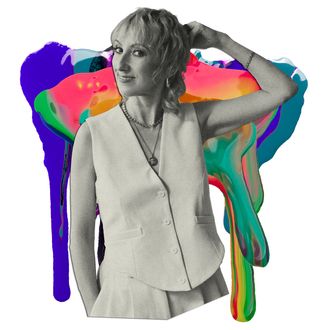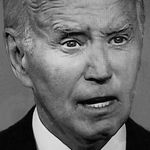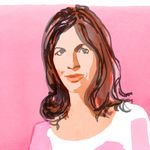
Before she took the reins as executive director of the Leslie Lohman Museum of Art, the only institution in the world dedicated to fostering LGBTQ+ art, Alyssa Nitchun had an eclectic résumé. She sold women’s lingerie at Patricia Field, managed Agent Provocateur’s original Soho boutique, DJ’d, fundraised for CUNY’s Center for LGBTQ Studies, and assisted Artforum’s publisher. “My professional path has been winding and marked by a lot of decisions that I have made because I want to do this or that out of love,” the New Jersey native says.
Nitchun joined the museum in 2020 after a six-year stint at the lauded public-art organization Creative Time. This year has been her most successful yet, as Leslie Lohman has raised a record $2.2 million that will go toward exhibiting its collection of over 30,000 artworks in different parts of the country and the world. “We will reach places where access to queer art is limited or nonexistent,” Nitchun says. The money will also go toward enlarging the museum’s footprint on Wooster Street with a renovation and expansion. Nitchun lives in New York; here’s how she gets it done.
On her morning routine:
I get up around 6:45-7 a.m. and write, stream of consciousness, for half an hour. I have been an inveterate journal-keeper since I was 10. This helps me process my thoughts and keep a record of my life. I have been very into resistance training. My mom has severe spine issues and I recently went to the doctor with her and was like, “What’s the number-one thing that I can do, you know, to prevent myself from being in the same shape as she is?” So I do a lot of yoga, I do a lot of Pilates, but now I’m getting into weight training. I go to the gym, come back, make a quick breakfast, have coffee, and then get into my day.
On managing stress:
I am a believer in a deep breath and in the psychological aspect of a “this too shall pass.” I will always be a raver. When I’m stressed, I love to just go dancing. Last Saturday, for example, I danced to a DJ friend who played at Basement from 2 a.m. to 4 a.m. Sex is a real stress-reliever, too. Pleasure is a through line that drives me.
On the challenges of running a queer art space:
A huge part of my job is to hold space for the full intersectionality of the LGBTQIA+ identity. Under the umbrella of queer, there are so many different experiences, intersections, and marginalization trauma. With art added into this mix, I have to consider different levels of emotionality and empathy. The biggest challenges, however, are financial, because there is no lack of extraordinarily talented artists, no lack of creativity. There is no lack of folks who want to work at Leslie-Lohman. There is a challenge around economy and budget. Art philanthropy and funding is deeply deprioritized, and if you add “queer” into that title, funding falls even a few more pegs.
On her approach to fundraising:
Fundraising is a really special value proposition. You are inviting someone to contribute to an act of creativity, to an active generation of something deeply personal which can only happen if they support it. I try to come at fundraising from a really human perspective. I always credit Anne Pasternak, the director of the Brooklyn Museum, who hired me as the development director at Creative Time when I didn’t have a ton of fundraising experience — she said “I believe in you; I know you can do this.” What I learned from her is really connecting person to person, realizing that art lives in a place almost outside of language. I try to take a step back from just the dollar sign and make sure what I am inviting a potential stakeholder into is enjoyable and fun for everyone.
On getting her start in fashion retail:
Executive directors are being asked to do so many wildly different things that the role requires a diverse skill set. The best training is by having held a lot of different positions, including in service industries. Working at Patricia Field was one of my most important career moves. My first job out of college was at Artforum, which I left to sell lingerie at Patricia’s 8th Street store. I was so deeply drawn to the community that shopped and worked there. Everything embodied a lived, queer utopia that Pat had created. She was this fierce, highly visible lesbian, outspoken, deeply creative, and very powerful. I’m taking a lot from her. What I do at Leslie-Lohman is this radically affirming space of collective meaning making, of imagination, of creativity.
On what she learned from selling lingerie:
I helped to open Agent Provocateur’s first store in the U.S., and we had a wide cross-section of shoppers from sex workers to celebrities. Because of the nature of the stuff that they were selling, a lot of gender-nonconforming and trans folks stopped by, too. This was very early, new millennium, and I was exposed to all kinds of bodies. Both Agent Provocateur and Pat had this body-positivity ethos which is still instilled in me. I learned to feel comfortable in my own skin and also an understanding of sexuality and desire, the way it moves so powerfully through all bodies.
On finding moments to unwind in a very public-facing job:
There is no after-work, really. I like my life being woven together with my job, friendships, pleasure, and inspiration. There is always a work-related dinner, an opening, or a program either at the museum or at another institution. This can sometimes be deeply fatiguing. I try to at least have two nights when I have nothing and use the time to replenish. I am not a nine-to-five person. I want my whole life to keep investing back on itself, which is what brought me to the art world in general. At its best, it is a place that lets you fly your freak flag and honors that.
On how her job has influenced her personal style:
Since I was a little girl, I was dressing up and had this sense of fashion as performance and as armor. My initial plan was to study fashion, which still feels very much a part of my identity. As a very femme-presenting person, I have seen in my role at the museum that the femme part has become less soft, more angled. I am all about super sexiness, but in my position, subconsciously, I have felt the need to become a little bit harder in self-fashioning. This may be a form of protection and legitimizing my space in places of power where women still are not really welcome. Believe me, misogyny is alive and well, even in the LGBTQ+ world and in museum leadership.
On the people who help her get it done:
I can’t not thank my team and my board. As a female executive director, I am all about horizontality, collaboration, and listening. I have hired almost every single person working there myself, so my success is predicated on the team that I have built. It is also my queer tribe of people who have my back. I am thankful for my friends who understand that this job requires a tremendous amount of time. Sometimes there is a period in my life where I have less to offer, and this does not mean I love them any less.
On the advice she wishes she had earlier in her career:
What I say to people is, follow your bliss. Follow what is speaking to you at any given time and know that it won’t be wasted. Even if things don’t quite make sense as you’re building your career, it all comes together. Getting my master’s in gender politics and queer theory seemed like, Well, what am I going to do with that?, especially when I first went into the art world. Now I’m running a space where those experiences are feeding back together.
This interview has been edited and condensed for length and clarity.




